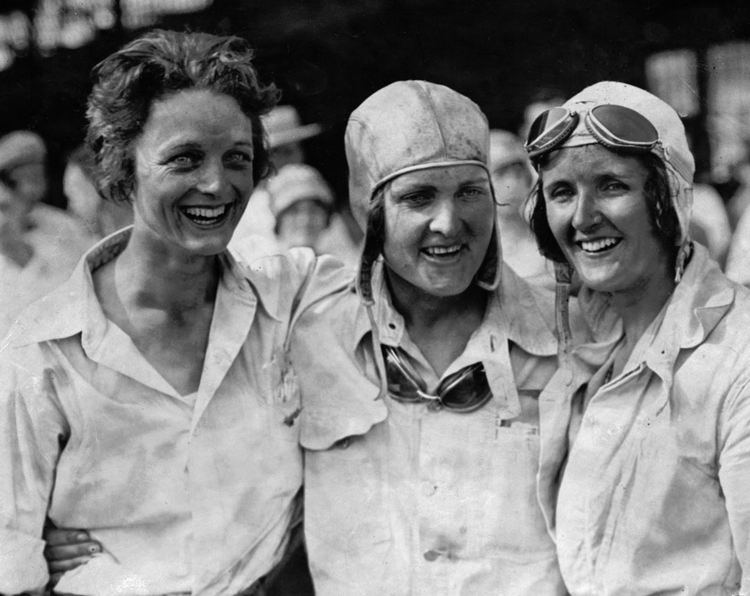Dates 18 Aug 1929 – 27 Aug 1929 | ||
 | ||
Women's Air Derby was the first official women-only air race in the United States, taking place during the 1929 National Air Races. Humorist Will Rogers referred to it as the Powder Puff Derby, the name by which the race is most commonly known. Nineteen pilots took off from Santa Monica, California on August 18, 1929 (another left the next day). Marvel Crosson died, in a crash apparently caused by carbon monoxide poisoning, but fifteen made it to Cleveland, Ohio, nine days later.
Contents
Women s air derby aka humans air derby 1929
The race
During the first two decades of heavier-than-air flying, the few women fliers in the United States became acquainted with one another during air meets and air rodeos. The bonds among the top women pilots were strengthened in the first real race for female pilots—the Women’s Air Derby during the 1929 National Air Races and Aeronautical Exposition. Air-race promoter Cliff Henderson was the founder of the first Women’s Air Derby, which he patterned after the men’s transcontinental air races. (Ironically, Henderson would ban women from competing in the 1934 Bendix Trophy and National Air Races after a crash which claimed the life of pilot Florence Klingensmith in 1933.)
To qualify, pilots had to have at least 100 hours of solo flight, which included a minimum 25 hours of cross-country flying (these were the same rules that applied to men competing in the National Air Races). The twenty competitors, eighteen of whom were from the United States, were:
One of the qualifications was that the aircraft would have to have horsepower "appropriate for a woman." Opal Kunz was told her airplane was too fast for a woman to handle, and had to get another craft or stay out of the race. "...Though Opal Kunz owned and flew her own 300 horse power Travel Air, it was disallowed since it was deemed by the judges to be 'too fast for a woman to fly.' With $25,000.00 in prize money at stake, she found a lesser horsepower craft to race."
The pilots, fourteen in the heavy plane class and six in the lighter class, took off from Santa Monica, California. To keep all competing aircraft safely separated as they climbed to altitude, they were lined up in rows at the start of the race and took off at one-minute intervals, the lighter aircraft first. National Aeronautic Association official Joe Nikrent was the official timekeeper. Earhart had an electrical problem and had to return to the airfield, but repairs were made quickly, and she resumed flying.
Almost every pilot suffered mishaps during the difficult race. Marvel Crosson crashed in the Gila River Valley and was killed, apparently the victim of carbon monoxide poisoning. There was an outcry demanding the race be canceled, but the pilots got together and decided the most fitting tribute would be to finish the derby. Blanche Noyes had to put out a fire that erupted in mid-air over Pecos, but continued on. (In the 2010 documentary Breaking Through the Clouds: The First Women's National Air Derby, Noyes, a non-smoker, explained that she found a cigarette butt in her baggage compartment.) Margaret Perry caught typhoid fever. Pancho Barnes crashed into a car that drove onto the runway as she was trying to land, wrecking her airplane. Ruth Nichols also crashed. Claire Fahy's wing wires were eaten through, possibly sabotaged with acid; she withdrew from the race.
An estimated 18,000 people gathered in Cleveland, Ohio, to greet the pilots at the end of the race. Louise Thaden finished the race first and won the heavy class in a time of 20 hours, 19 minutes and 4 seconds. Phoebe Omlie won the light class in 25 hours, 12 minutes and 47.5 seconds.
Standings
Heavy class:
- Louise Thaden
- Gladys O’Donnell
- Amelia Earhart
- Blanche Noyes
- Ruth Elder
- Neva Paris
- Mary Haizlip
- Opal Kunz
- Mary von Mach
- Vera Dawn Walker
Four women completed the race in the light class (order unclear, other than Omlie finishing first):
Bobbi Trout finished the race, but was untimed.
Depictions
The race was the subject of the 1935 novel Women in the Wind: A Novel of the Women's National Air Derby by Francis Walton and the 1939 film adaptation, starring Kay Francis.
